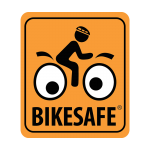
Making neighborhoods better with protected bike lanes
Recreation is an essential part of our well-being, and our neighborhoods are at the heart of this tradition, owing to their singular location: just outside our front door. While every neighborhood is different, the view outside our front door is all too often a conveyor belt of tarmac, designed to move automobiles quickly at the expense of all others’ safety – namely, anyone walking down the street or attempting to ride down it on a bicycle.
It is little wonder parents’ rally cry of “Go outside and play!” is not as common as it used to be.
The traffic we live in may seem normal to those of us who grew up with it, but we tend to overlook that it is a product of choices made by cities since the 1930’s; choices that moved cities away from human-oriented transportation in favor of motor vehicles.
This is especially true for bicycle riding, even in our neighborhoods. Cyclists are often placed side-by-side with automotive traffic – not exactly the epitome of relaxation – or are expected to use the sidewalk, posing a hazard for pedestrians.
Protected bike lanes are part of the solution that can benefit everyone – including drivers and pedestrians – in the effort to make cycling safer. These are conventional bike lanes (or a pair of bi-directional lanes, often dubbed a “cycle track”) with an added physical barrier that provides a safety buffer from automotive traffic. Some of these barriers are as simple as rubber traffic pylons, while the safest designs have physical curb separation.
In South Florida, protected lanes are not widespread, but recent initiatives, such as the proposed Gables Greenways1 in Coral Gables and pending state legislation (HB 117, 20182 Update: Bill was postponed and subsequently withdrawn as of 3/10/2018), have brought them to public attention.
You can actually ride around with your kids without having to be in constant fear of cars, cross the street without having to dash across huge boulevards, and enjoy slower and less frequent traffic.
When properly built, protected bike lanes offer a level of safety3 for both bicyclists and pedestrians that no other on-street design affords. Not only does the physical barrier prevent motor vehicles from straying into the cyclists’ lane, wide buffer zones sometimes double as a pause area for pedestrians, shortening the distance required to cross a street safely. Since protected lane construction often requires narrowing the main vehicular travel lanes, people tend to drive slower on these streets as well.4
Safety is not the only thing that a protected bike lane affords. A complete network can strengthen a community and reduce the amount of vehicular traffic on the road.
For instance, a complete network of protected bike lanes linking a neighborhood to a city’s central business district means someone could conceivably leave their home to get groceries, drop off some mail, and have a coffee, all while enjoying the equivalent of a weekend bike ride.
In short, protected bike lanes can link an entire community together and make a city more livable for everyone. You can actually ride around with your kids without having to be in constant fear of cars, cross the street without having to dash across huge boulevards, and enjoy slower and less frequent traffic.
It is an opportunity to make the world we live in a little better.
- https://www.gablesgreenways.com/
- https://www.flsenate.gov/Session/Bill/2018/117/ByVersion
- http://peopleforbikes.org/blog/the-first-major-academic-study-of-protected-bike-lanes-in-the-u-s-is-out/
- https://www.citylab.com/design/2014/10/why-12-foot-traffic-lanes-are-disastrous-for-safety-and-must-be-replaced-now/381117/



